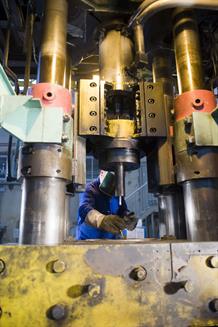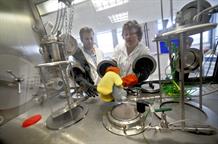The materials at the heart of innovation
for tomorrow's nuclear power plants
Sodium-cooled fast reactors (SFRs) are the reference technology for Generation IV fast reactors. In this context, the CEA is the owner of a technology demonstrator project, called Astrid, which is currently in its design phase. Yet, Jean-Luc Béchade (head of service) and Yann de Carlan (research director on high-performance steels) at the CEA Nuclear Energy Division are keen to emphasise: “
The implementation of this new technology, incorporating Generation IV criteria, is a challenge for material science”. The coolant has different chemical properties (liquid sodium rather than water as in the existing fleet of PWRs), high core temperatures (400 to 650°C, as opposed to 325°C), and more energetic neutrons. In future reactors, materials will be subjected to more severe stress than they face in current facilities. In the majority of cases, new materials will need to be used! This is driving the 'upstream' research by various CEA teams which aims at identifying new metals and ceramics, while validating the need to performance-test them on purpose-built experimental platforms.
New and even more resistant alloys
In PWRs, the cladding
enclosing the fuel pellets is made of zirconium alloy. The first sub-assemblies used in the Astrid reactor will be made of austenitic steel. Except that Jean-Luc Bechade and Yann de Carlan had this to say: “
We know that fast neutrons produced by SFRs can create cavities in these alloys, which end up swelling or increasing in volume”.
1 Oxide Dispersion Strengthened
2 Deformation at high temperature is lower and the recombination of irradiation defects is higher
3 Facility designed and financed in part by the CEA
4 If materials were to become liquid during welding, this would destroy their nanostructure
5 These techniques make it possible to weld these steels while solid. They have been developed and used in the Department for Modelling Systems and Structures (DM2S)
Astrid’s austenitic steel cladding needs to be changed every “100/120
dpa” even though the fuel inside this cladding will not have been completely spent. In 2007 and using this fact as a starting point, researchers set about developing a new material for this reactor technology that would be able to better withstand the cumulative effects of irradiation and high temperature: ODS steel
1. First developed in the 1960s, this family of alloys based on iron, carbon, chromium and other minor elements is better able to withstand this type of stress because of the yttrium oxide nano-particles dispersed in it. Today, the team will need not only to identify the reference
grade for the studies, but also to evaluate some of its characteristics on the JANNuS facility. This is an essential stage before being able to continue to the next phase: developing a manufacturing process which is transferable to a manufacturer and performance-testing the material under neutron irradiation. Only once this has been achieved will ODS steels replace austenitic steels.
ODS steels: manufactured, assembled and tested by the CEA
To achieve these objectives, the CEA has installed a complete facility to manufacture these ODS steels, just like would be found in a real powder metallurgy plant. Mechano-synthesis by grinding powder in an
attritor, consolidation at 1,100°C by 'hot extrusion' or 'isostatic compaction', drilling tubes, and hot and cold conversion: all these processes allow researchers to produce around ten of these cladding assemblies a year. This cladding will need to be 1.5 times more resistant to irradiation by fast neutrons than cladding made of austenitic steel!

Hot extrusion of ODS steel cladding on the CEA/DEN fabrication line at the Saclay centre © P.Stroppa/CEA

Studies on the corrosion of materials in sodium environments using the CORRONa2 platform belonging to the CEA/DEN at the Saclay centre © P.F. Grosjean/CEA
Since the microstructure of these new materials is very specific
2, extremely high-tech analytical tools need to be used to characterise them. For these reasons, the CEA has contributed to the development of the MARS beamline at the Soleil synchrotron facility at Saclay
3 which is used for detailed characterisations prior to, but especially after irradiation. This involves checking that the nano-oxides remain stable after time in the reactor and that, even with a strong neutron flux, they can still strengthen the material. The current experiments have been very conclusive. Finally, since these materials cannot be welded using conventional methods
4, new assembly techniques using resistance welding or friction welding have been developed by researchers
5.
Nuclear materials' corrosion under the microscope
In addition to the stress of irradiation and high temperatures, the materials used in SFRs must also resist corrosion. Undoubtedly, liquid sodium is a much less harsh fluid compared with water which is still used as the coolant in PWRs. “
Added to this is the fact that in practice, it still contains impurities, carbon or dissolved oxygen which can, as a result of oxidation and carburation phenomena, damage the surfaces of the core equipment and in the end affect the lifespan of the facility”, explained Fabrice Legendre and Raphael Robin, service manager and laboratory manager respectively at the CEA Nuclear Energy Division. Scientists would like to performance-test the materials so as to quantify the risk and determine which products are created from their corrosion, among others in order to determine the best size for the 'cold traps' designed to filter the liquid sodium in the future reactors. To this end, two R&D platforms were built at Saclay: the “CORRONa” loops, consisting of a series of glove boxes, placed in an inert argon atmosphere and connected to 'pots' containing several litres of liquid sodium heated to 650°C. By exposing samples in this hot fluid for several thousand hours and accurately characterising them with special optical tools, the team can perform all sorts of static, hydrodynamic and
tribological experiments. Used in models or to refine them, these results can be used to predict how these alloys will age due to corrosion over a number of decades and establish the correct component size accordingly. A dozen metal grades, involving hundreds of samples, have therefore already been tested. One material, 316 LN steel, has in fact been chosen as a 'reference material' for the tanks and internals of future Generation IV sodium-cooled fast reactors.